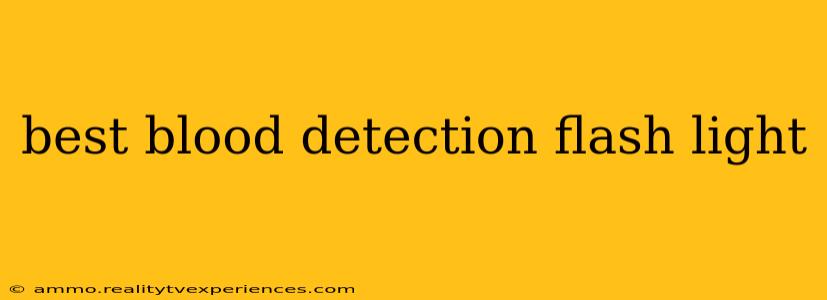Finding the right flashlight for detecting blood can be crucial in various situations, from crime scene investigations to medical emergencies. This guide will help you navigate the options and choose the best blood detection flashlight for your needs. We'll explore the key features to look for, different types available, and factors to consider before making your purchase.
Understanding Blood Detection Technology
Before diving into specific flashlights, let's understand the technology behind blood detection. Many flashlights designed for this purpose utilize alternate light sources (ALS). These ALS flashlights emit light in specific wavelengths, often within the ultraviolet (UV) or blue light spectrum. Blood, and other bodily fluids, react differently to these wavelengths than other substances, making them easier to identify. This is because certain components of blood, like hemoglobin, fluoresce under these specific wavelengths. The fluorescence appears as a reddish-orange glow under an ALS.
Key Features of a Good Blood Detection Flashlight
Several key features differentiate a good blood detection flashlight from a standard one. Consider these factors when making your selection:
-
Wavelength: The most critical factor. Look for flashlights emitting in the 410-470nm (blue light) or 365nm (UV) range. These wavelengths are most effective in causing blood to fluoresce.
-
Intensity: A brighter light source will generally lead to better visualization of the bloodstain. Consider the lumens rating. Higher lumens mean a brighter light.
-
Filter: Some flashlights include interchangeable filters to optimize the wavelength emitted for different applications.
-
Portability and Durability: Consider the size and weight of the flashlight, especially if you need to carry it for extended periods or in challenging environments. A durable, weather-resistant flashlight is a worthwhile investment.
-
Battery Life: The longer the battery lasts, the more effective the flashlight will be. Check the battery type and expected runtime.
-
Focus Adjustment: The ability to adjust the focus from a wide beam to a narrow, concentrated beam can be helpful for detailed examinations.
Types of Blood Detection Flashlights
Several types of flashlights are designed specifically for blood detection:
-
Dedicated Blood Detection Flashlights: These flashlights are specifically engineered for this purpose, often incorporating features like optimized wavelengths and durable construction.
-
Forensic Flashlights: While not always explicitly marketed for blood detection, many forensic flashlights are designed to emit in the appropriate wavelengths and often have other features useful for crime scene investigations.
-
UV Flashlights: While not all UV flashlights are created equal, those emitting at 365nm can be effective for blood detection. However, ensure that it's specifically designed for this purpose and has sufficient intensity.
Choosing the Right Flashlight for Your Needs
The best blood detection flashlight will depend on your specific requirements. Consider these factors:
-
Application: Are you a law enforcement professional, a first responder, or using it for other purposes?
-
Budget: Prices vary significantly, depending on features and brand.
-
Frequency of Use: If you use it daily, investing in a high-quality, durable flashlight is recommended.
Conclusion
Selecting the best blood detection flashlight requires careful consideration of the key features discussed above. By understanding the technology and matching the flashlight's capabilities to your needs, you can choose a reliable and effective tool for detecting blood in various settings. Remember to always prioritize safety and follow proper procedures when handling evidence or bodily fluids.

